
The Old Telegraph Line
by the Captain

The Old Telegraph Line
by the Captain
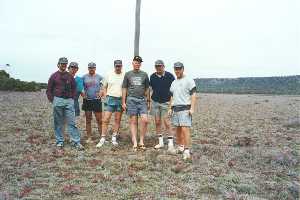 On the South East corner of Western Australia lies one of
the most isolated telegraph lines ever built. The Old Telegraph Line, built circa 1870,
provided the earliest direct communication with the Eastern States. After experiencing the
remoteness of its location, we never ceased to be amazed at the skills of those early
pioneers in building this link.
On the South East corner of Western Australia lies one of
the most isolated telegraph lines ever built. The Old Telegraph Line, built circa 1870,
provided the earliest direct communication with the Eastern States. After experiencing the
remoteness of its location, we never ceased to be amazed at the skills of those early
pioneers in building this link.
In the climate-controlled cabins of our vehicles, filled with all the necessities and modern communication equipment, the location seemed extremely remote.Back in 1870, it would have seemed like, and literally was, the end of the world.
As part of an eight day tour, the final leg of the trip was to start at the Telegraph station at Israelite Bay and emerge east of Balladonia Roadhouse on the Nullarbor plain. The plan was to follow the telegraph line to where the Wylie Scarp becomes the Great Australian Bight. This involved a total trek of some 2500 kilometres of travel from home with 4 days of travel being in some very isolated terrain.
Our final staging point was Esperance, where we filled our vehicles with fuel and water for the coming trip. The group of ten were amply accommodated in four vehicles, consisting of a dual cab Toyota Hilux, an 80 series Toyota Landcruiser, a GQ Nissan Patrol and the only petrol vehicle being a Daihatsu Feroza.
The Hilux was used as a diesel "tanker" and was fitted with an auxiliary 200 litre tank to supply itself and the Nissan. The Cruiser comes standard with 145 litre tanks, but a 20 litre jerry was carried for insurance. The Daihatsu needed to take some 5 jerry cans, but had to call in the services of the Cruiser to handle the load. In addition to the fuel load there was some 15 litres of water per person, recovery gear, fishing tackle, food, tents, chairs, fridges, RFDS radio and other paraphernalia, including a Weber BBQ !.
With creaking springs and high spirits we set off to our first stop, Poison creek. It was an easy trip of only 150 odd kilometres along progressively worse tracks before we were at the mouth of Poison Creek at the beachfront. The Daihatsu was sent to scout around the bay and find a protected camping spot, but found itself bogged on a particularly soft section of beach. The heavyweight Nissan and Toyotas decided to not follow the Daihatsu's lead, but decided to set up camp behind the dunes.
To make amends for its earlier bogging, the Daihatsu charged up a small dune and led the way. The Cruiser and Nissan made it over with a bit of encouragement, but the Hilux required a runup halfway back to Esperance. Even so, the 2.4 1 diesel required a helping hand to finally crest the dune.
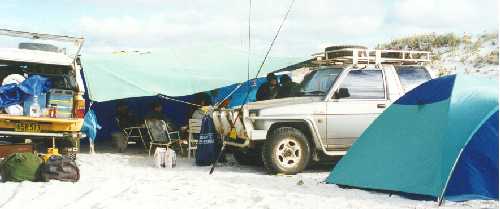
Camp was set up in no time, with the four vehicles positioned in a large square to enable a tarp to be strung between them. After a quick bite for lunch, the keener fishermen of the group soon baited up and were enjoying a spot of beach fishing, while the remainder enjoyed a cold beer. Up to now the weather had been fine but the remnants of a cyclone up north of the state was making its way down south. We would need to keep an ear out for the forecast each day as the weather could turn nasty very quickly.
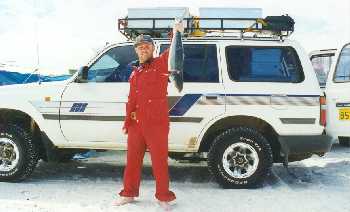 Before long, the first of several large
salmon and mulloway were caught. The fish would have to wait for breakfast, as dinner was
a leg of roast lamb done to perfection in a weber. The weber was just another one of those
"essential" items we couldn't do without!
Before long, the first of several large
salmon and mulloway were caught. The fish would have to wait for breakfast, as dinner was
a leg of roast lamb done to perfection in a weber. The weber was just another one of those
"essential" items we couldn't do without!
After a much needed sleep-in the next morning, followed by a feast of fresh fish cooked in the weber, we set off to Israelite Bay via Fisheries road. The journey out of Poison creek was uneventful and we soon found ourselves on Fisheries road. It is actually just a well-defined track that would be just about impassable in the wet, but was quite easy in the dry.
The terrain was slowly changing from undulating bush to flat low lying scrub. The track passed over what was the beginning of the Wylie Scarp, some 50 odd kilometres from the coast. As long as the scarp was on our left and the coast on the right we couldn't go wrong, because the scarp would form the Great Australian Bight in 200 kilometres time.
The track eventually skirted some large salt flats
and in the distance we could see the remnants of Israelite Bay Telegraph station. It was
hard to imagine the difficulties that must have been encountered in the late 1870's when
the station was first established.

It was a magnificent building, with only the limestone walls now remaining. The roof and floor were long gone, presumably to fire at some stage, but the graffiti on several areas was disappointing. Some of the initials carved into the fireplaces dated back to the 1940's and made for interesting reading. Heritage Listing signs were prominent along with keep out signs, which were obviously obeyed by no-one, given the litter and graffiti surrounding the building.
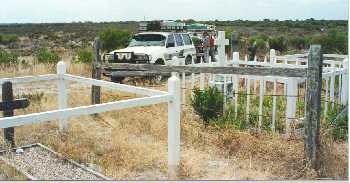 Not far from the station was the
local cemetary. Interestingly, all 3 graves had the christian name of John!
Not far from the station was the
local cemetary. Interestingly, all 3 graves had the christian name of John!
It was here the convoy split up, with the Patrol staying put for an overnight stop before heading to Balladonia via the "road". After a quick bite for lunch, the Cruiser, Hilux and Daihatsu fuelled up from the supplies and set out along the beach. The Daihatsu took the lead and within 500 metres it found itself bogged to the chassis in some "quicksand" and was still sinking.
Like a white knight in armour, the cruiser wheeled around and had a snatch strap set up in minutes. With a puff of black smoke from the diesel, it was off at full pelt with some 3 metres of slack in the snatch strap. This resulted in a spectacular recovery of the Daihatsu, all four wheels nearly coming completely clear of the quicksand as it was launched backwards.
Beach driving is great fun, but its treacherous bog holes like this that can catch out those unprepared. It was good practice to have the lightweight Daihatsu in the lead, followed by the Hilux, with the "recovery vehicle" Cruiser bringing up the rear. Recovery equipment fitted included 8,0001b electric winch, snatch blocks, tirfor, highlift jacks, snatch straps, extension cables, drag chains, air bag jack, chainsaw and a multitude of other items. This may seem to be an overkill of recovery gear but given the isolated location and unknown condition of the varying terrain it was comforting to think we could get ourselves out of almost any predicament. Failing that, an RFDS radio was carried as final insurance.
Finding this section of beach impassable, we headed inland and after a few false starts we soon found the Telegraph line. The track was initially well defined, but quickly deteriorated to very faint wheel tracks with only the occasional remaining telegraph pole to confirm we were on the right track. In places the track was so overgrown with Banksia trees that the white Cruiser was soon black down the sides from the blackened tree branches.
It wasn't long before some side bump strips were missing, along with one of the side indicators. The track was also very rough with 1st and 2nd gear being the order of the day. It took over two hours to cover less than 40 kilometres. What was initially an exciting track was quickly becoming a tiring and expensive journey. When the track broke out onto some saltflats, it provided a welcome break from the bone jarring and vehicle scratching overgrown tracks.
Wattleup Camp was our destination for the night and what we thought was going to be a relatively short day took longer than expected, due to the rough track. We soon made better time due to the kilometres long saltflats, which was just as well because it was almost dusk. With the light fading fast, we could not find the Wattleup Camp as marked on the map, so we decided to stop at the next suitable spot.
While listening to the 6 o’clock news, we heard the forecast of heavy rain and potential flash floods, raindrops started to blur the windscreen. The cyclone up North had turned into a rain bearing depression and was slowly catching up with us. As we were travelling on long saltflats with no end in sight, the thought of flashfloods was not a pleasant one.
Headlights and spotlights were required and the search for high ground was on in earnest. A small sand dune appeared in the middle of the track and after a quick CB conversation, it was decided to stop there for the night.
| The three vehicles were parked in a triangular fashion and a tarp set up between them. After the evening meal was prepared, tents were set up under the tarp to shield them from the expected rain. Going to sleep that night, everyone had visions of waking in the morning and finding ourselves stranded on our sand dune island with flood waters all around | 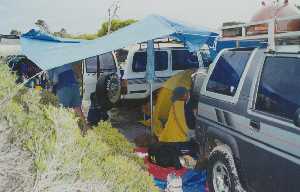 |
Luck was on our side with hardly any rain at all that night and clear skies in the morning. The track was now skirted the saltflats and was no longer so overgrown. This allowed us to make good time with it wasn't long before the Wylie scarp had grown from a distant rising to an impassable cliff ledge only a kilometre from us.
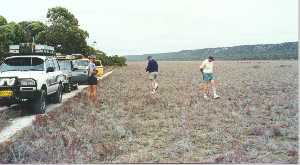 |
We were still travelling parallel to the coast and the Wylie scarp was rapidly converging, soon to become the cliffs of the Great Australian Bight. |
We had been warned that the final climb up the scarp was a long, steep and difficult sand dune that may require winching for the heavier vehicles. The Daihatsu was the first vehicle to attempt the climb, but it only reached halfway. The Hilux tried following, but barely made it past the starting line and this left the Cruiser stuck behind the Hilux. Tyre gauges were whipped out and pressures lowered to 15 psi.
The lower tyre pressures made all the difference and it wasn't long before all vehicles were at the top of the scarp with tyres were being pumped back up again. We were all glad that none of the vehicles had to be winched, with the only recovery equipment used on the whole trip being the snatch strap when the Daihatsu was stuck in "quicksand".
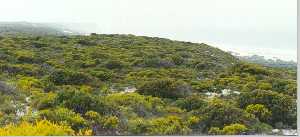 From the top of the Wylie Scarp, the Great Australian Bight could be seen in
the distantance throught the cloud haze.
From the top of the Wylie Scarp, the Great Australian Bight could be seen in
the distantance throught the cloud haze.
The track at the top of the scarp was more of a clay soil than beach sand and was littered with plenty of rocky outcrops. This made for relatively slow going, with the suspension in the Daihatsu being declared non-existent and a trip to the dentist required to replace some fillings!!!
It seemed like forever, but was actually only some 20 kilometres, before the terrain smoothed out, allowing for higher vehicle speeds. When the Nullarbor road was finally reached, our trip was nearly at an end, though we were still some 1,000 kilometres from home. We emerged onto the "Worlds Longest Straight Road" and headed towards Balladonia Roadhouse.
We caught up with our friends in the Patrol who we had left behind at Israelite Bay. We were not exactly welcomed with open arms, as having fished for several nights with no showers, we were all a bit on the nose by the time we arrived at Balladonia. We parted company once again as they were awaiting relatives coming from the Eastern States.
As we still had ample fuel supplies, we headed for home, stopping at Norseman to top up our tanks. The Cruiser had used 110 litres of diesel for some 724 kilometres, not bad considering the terrain. The Daihatsu used some 90 litres while the Hilux was still using its auxiliary tank and didn't need to top up.
We decided to have a look at Wave Rock on our way home, so took a minor gravel road just out of Norseman that led almost directly to Wave Rock.
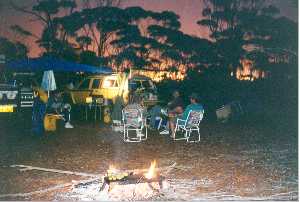 We camped for the night about halfway to Wave
Rock and as this was to be our last night of the trip, we polished off our remaining
liquor supplies. This led to a late start and some sore heads the next day .
We camped for the night about halfway to Wave
Rock and as this was to be our last night of the trip, we polished off our remaining
liquor supplies. This led to a late start and some sore heads the next day .
After the remoteness and isolation of the Telegraph Track, Wave Rock suddenly seemed very crowded and too tourist orientated for our liking. But it allowed us to ease our way back to "civilisation" from the harsh, arid environment of the Telegraph Track.(c) 4WD Encounter 1998
These pages were last
updated on 17th September 1998.
Hits since 25th May 1998: